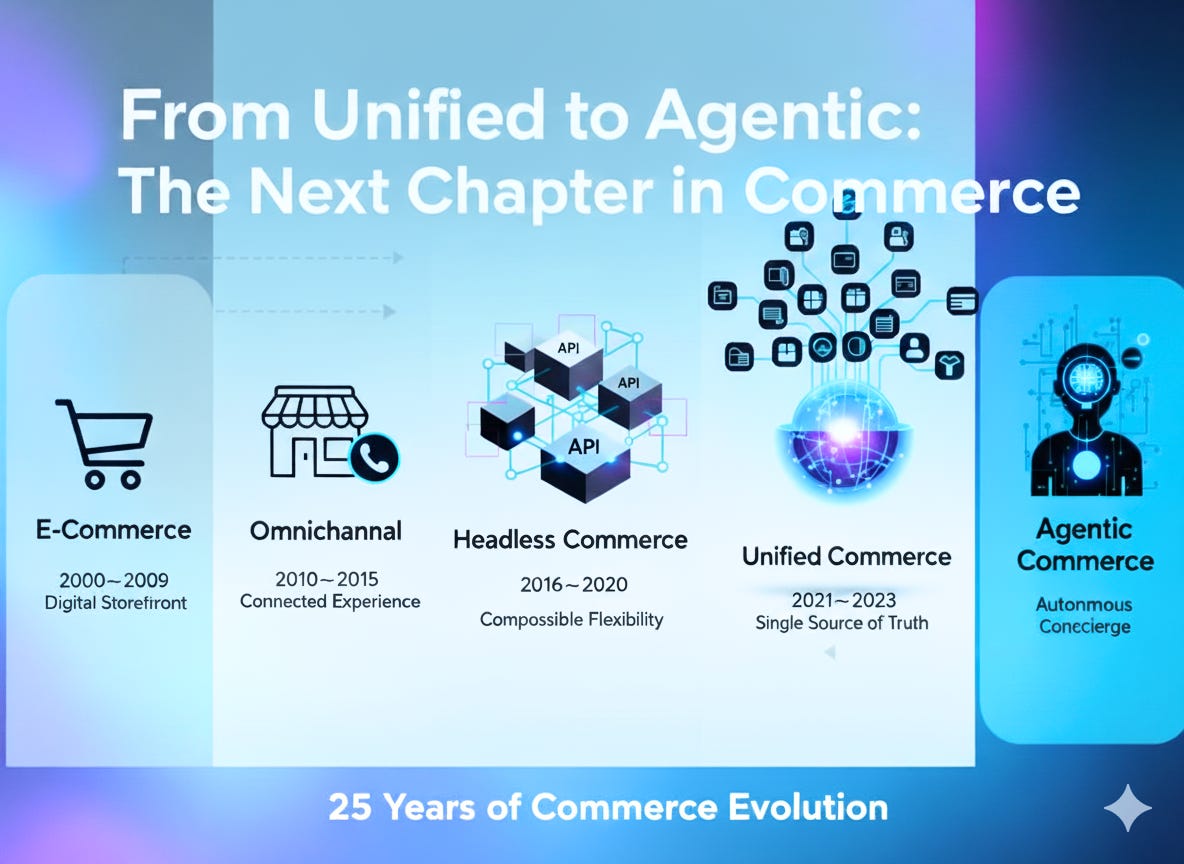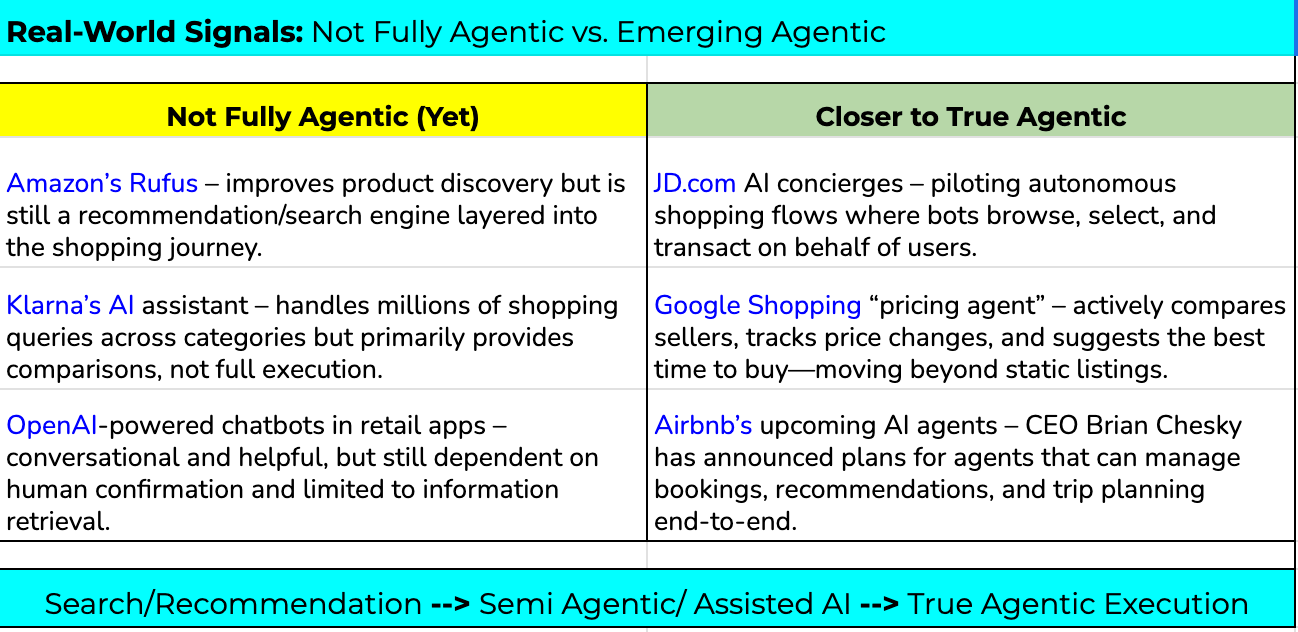From Unified to Agentic Commerce: The Next Chapter
How AI Agents are shaping the Next Era of Commerce
It was only recently that brands & retailers were gaining confidence in diverting their investment dollars behind the concept of Unified Commerce- where every channel is stitched together on a unified platform, every inventory count is reconciled with an ultimate objective to have a “single source of truth.”
But almost overnight, the conversation shifted again.
What was hailed as the holy grail just a year ago now feels like regular plumbing. The spotlight has moved to something new, something much harder to grasp: Agentic Commerce.
This is the paradox of our fast-changing time. Unified Commerce was supposed to be the endgame. Instead, it has now become the starting point for a far bigger transformation. The question isn’t just what Agentic Commerce is, but why this shift is happening so fast, how many organisations are actually ready to adopt this new wave of commerce and most importantly, what can retailers and brands do right now to stay relevant.
But first, let's take a quick look at this fascinating evolution of commerce unfolding in-front of us.
The Great Leap Forward: 25 Years of Commerce Evolution
If you dig into the last 25 years, commerce has never stood still. We can clearly see 5 distinct eras, each built on the last, reshaping how consumers discover, decide, and buy.
2000–2009: The E-Commerce Genesis
The early 2000s were the era of the digital storefront. A simple relationship: a shopper sat at a computer, browsed a website, and completed a transaction. Amazon, eBay, and Alibaba established the model- digital carts, one-click checkouts, and global reach.2010–2015: The Omnichannel Expansion
As smartphones and apps exploded, commerce broke out of the digital box and merged with physical stores. This was the era of the connected experience: buy online, pick up in-store; return in-store; browse an endless aisle from your phone. Retailers invested heavily in making experiences consistent across channels.2016–2020: The Headless Liberation
Next came the architectural shift. The front-end storefront was decoupled from the back-end engine, unleashing agility. Brands could innovate faster, launching new touchpoints without being tied to monolithic platforms. Think of this as the Lego block era of commerce. The founding of the MACH Alliance in 2020 gave this movement its global manifesto: Microservices, API-first, Cloud-native, Headless.2021–2023: The Unified Consolidation
Inevitably, the pendulum swung back. With complexity everywhere, retailers realized they needed a central nervous system. Unified Commerce became the infrastructure backbone- a single source of truth for orders, inventory, customers, and payments. CommerceTools, Shopify, Salesforce, Oracle, and Adyen championed this model. For a brief moment, it felt like we had arrived.2024–2025: The Agentic Emergence
And then came the shockwave. Suddenly, AI agents -autonomous systems capable of browsing, comparing, negotiating, and even buying, burst onto the scene. This wasn’t a marginal feature; it was a new interface layer entirely.If Unified Commerce was the nervous system, Agentic Commerce is the autonomous concierge standing between your brand and your customer.
Enter the Agent: The New Player in Commerce
So what exactly is Agentic Commerce?
At its core, Agentic Commerce is about AI agents acting on behalf of consumers. Unlike a chatbot or recommendation engine, these agents don’t just assist; they act. They can take a simple prompt- “Find me the best running shoes under $150 that deliver by Friday” and execute it end-to-end.
End-to-end execution: what does it mean? Well, you can think of it as a combination of discovery, negotiation & purchase.
Product Discovery: Agents can browse multiple sites, scan catalogues, check reviews, and filter options without human guidance.
Negotiation & Purchase: They can compare prices, apply coupons, ensure availability, and complete a checkout seamlessly.
All this can be done via multimodal inputs, i.e. through voice, text, or image. With this, agents can understand natural intent and translate it into action.
What Agentic Commerce is NOT
There’s a lot of hype around the word agent right now, and it’s worth clarifying what doesn’t qualify as “Agentic”
Not just automation. A scripted workflow that follows pre-coded rules isn’t an agent. Agents are adaptive and can make autonomous decisions.
Not just a chatbot. Chatbots respond within fixed boundaries. Agents go further; they interact with systems, make choices, and execute tasks.
Not just a recommendation engine. Personalisation is useful, but agents don’t just suggest; they decide and close the loop.
Not “human-in-the-loop.” Agents don’t merely assist; once intent is given, they can act independently to complete the journey.
In short: Agentic Commerce isn’t about better interfaces; it’s about autonomous intermediaries that operate between customers and brands.
Why This Matters
Shift in Power: The entry point for commerce is no longer the storefront. It’s now the agent. If your brand isn’t visible to the agent, you’re invisible to the customer.
Redefinition of Loyalty: Winning over the agent may matter more than winning over the shopper. When agents optimise for speed, convenience, or price, brand loyalty risks erosion.
Compressed Journeys: What once took multiple clicks and touchpoints now happens in a single intent-driven step. Shopping journeys are going to get majorly impacted.
New Discovery Battleground: SEO won’t be enough. Commerce data will need to be structured, discoverable, and interpretable by agents. We now have to optimise for Agents.
Each of the above-mentioned implication is not small and will / can have a transformational impact on how we shop and engage with brands.
The Big Elephant in the Room: Are We Ready?
Here’s the uncomfortable truth: most retailers are not.
Even in 2025, a large percentage of retailers are still trying to solve Unified Commerce 101 - getting clean product data, ensuring real-time inventory visibility across channels, integrating payments, and stitching together a single customer view.
When you zoom out, you see three tiers of readiness emerging:
Digital Natives (D2C, e-com first brands): These companies are closest to “agent-ready” because their data, APIs, and systems were born in the cloud.
Omnichannel Retailers (large chains, mid-market brands): Many have invested in Unified Commerce platforms, but integration is patchy. Product data is inconsistent, and APIs are not mature.
Traditional Retailers (legacy-heavy): For these, even basic digital plumbing is a struggle. Agentic adoption will take years without structural overhaul.
And yet, the Agentic wave won’t wait. Consumers won’t hold back their agents from shopping just because a retailer isn’t ready. Which brings us to the critical question: what can you do now to prepare without getting lost in the noise?
Your Agentic Action Plan: Two-Part Strategy
Step 1: Finish the Foundation (Unified as Plumbing)
Unified Commerce is not optional. It is the plumbing that makes you agent-ready.
Clean, consistent product data: Agents can’t buy what they can’t understand.
Real-time integration across orders & inventory: Agents require accuracy to transact.
APIs & composable services: Without open, modular systems, you won’t be able to plug into agent-driven ecosystems.
Step 2: Build for the Agent (Future-Readiness)
This is not about gimmicks. It’s about deliberately shaping your business to be discoverable, interpretable, and actionable by agents.
Here are concrete plays you can start now:
Agent-First Product Data: Audit your PIM (Product Information Management). Is your catalogue rich enough for machines? Can an AI parse your product images, videos, sizing, and attributes without human help?
Machine-Readable Offers: Move beyond banner ads. Structure discounts, promotions, and bundles as API-exposed objects so agents can factor them into purchase decisions automatically.
Agentic Pilots: Launch controlled pilots where AI agents handle narrow, low-risk use cases e.g., automated reordering of consumables, personalised replenishment reminders, or B2B procurement bots.
Design for Dual Customers: Start reframing your CX. The “customer” is both the human and their agent. Loyalty programs may need APIs so agents can seamlessly access, redeem, and optimise rewards.
Adopt an Agent Orchestration Platform: Don’t just react to external agents (Google Shopping, Klarna, JD.com). Bring agent orchestration in-house by experimenting with AI/ML platforms. For enterprises, solutions like Google Cloud’s Vertex AI and Agentspace, Azure AI Studio, or AWS Bedrock provide secure, scalable ways to build, orchestrate, and manage agents across commerce use cases. For prototyping and innovation, frameworks like LangChain or CrewAI let teams experiment rapidly with multi-agent workflows before scaling to enterprise-grade platforms.
The Next Chapter in Commerce Evolution is already being written.
Every era of commerce has created new winners. Amazon set the bar for e-commerce with the digital storefront. Walmart and Target showed what true omnichannel looks like by blending store and online seamlessly. Shopify and CommerceTools unlocked the headless, API-first era of flexibility. The Agentic era will be no different — it will create its own leaders, and the question is whether your business will be one of them.
The winners of the Agentic Era will be those who get two things right:
Unified Commerce as the backbone. Without it, agents can’t plug into your business.
Agentic readiness as a mindset. Building for discoverability, machine readability, and agent-first engagement.
The fact of the matter is that flashy apps won’t matter. Clean, connected, contextual data will.
The story of commerce is one of constant reinvention. The real question: will your business ride the Agentic wave or get left behind?
Suggested Further Readings
If you’d like to explore further:






Really great insights on the ecommerce evolution. Thanks for sharing !!
Really well written my friend